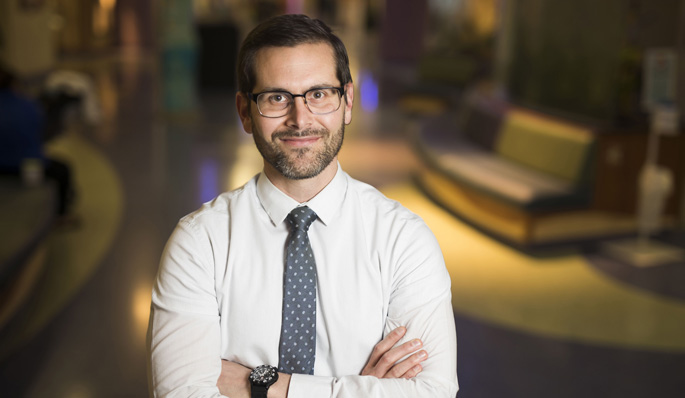
by Holly Fletcher
When James Carlucci, MD, MPH, instructor of Pediatric Infectious Diseases, is in Nashville he treats children at Monroe Carell Jr. Children’s Hospital at Vanderbilt. When he’s on one of the several trips he takes each year to Mozambique, he’s trying to understand when and why HIV-exposed infants fall out of care — and how to change it.
For many in the U.S., HIV faded into the background as treatment and outcomes advanced. Vertical transmission rates, or HIV infection acquired from mother to child, have decreased in many parts of the world from the era before antiretroviral treatment when it was around 25 percent. Now in the U.S. it is less than 1 percent, while in some areas of Mozambique it continues to be as high as 10 percent.
Carlucci published the first of two studies that resulted from three years of work based at the Vanderbilt Institute for Global Health. He is now continuing this work in Mozambique with Friends in Global Health, a wholly owned subsidiary of Vanderbilt University Medical Center.
Here’s what he wants to address, and how it relates to the rise of hepatitis C in parts of the U.S.
Talk about your research and why it’s important.
I initially got involved in global HIV research under the supervision of my mentor and former director of the Vanderbilt Institute for Global Health, Sten Vermund, MD, PhD. After several years we’ve found, which I was a little surprised by, that 40 percent of HIV-exposed infants in low- and middle-income countries globally, and particularly in Africa, are no longer in care by a year-and-a-half of age. I want to know what happens to these kids and what are the best strategies for keeping them in care. We don’t really know. I was expecting it to be a problem, but I wasn’t expecting the magnitude of the problem to be so big.
Moving forward, these are the sort of questions I want to try to answer in the framework of our Mozambique HIV programs. This study is getting published just as I’m getting some VUMC Faculty Research Scholars award funding, so I’ll be able to get that work started. It’s an exciting time.
What do you want people to take away from the study?
One, is to make people aware that HIV is still a big problem. It’s one of those things we don’t think about as much in the U.S. or in other higher-income countries as we once did — and that makes it harder to advocate for HIV research and funding to support that research in the places where the HIV epidemic is still a major problem but there are limited resources to address it.
The overarching theme, to me, is that there are a lot of people in low- and middle-income countries who are vulnerable populations, at unnecessarily high risk for diseases, including HIV. At least in my opinion, there is no reason why these kids should be exposed to HIV, let alone actually get HIV in some cases, and have poor outcomes because of it.
We have the technology and treatments needed to prevent mother-to-child transmission of HIV, but we need to better understand the contexts where the HIV epidemic is most severe so that we can optimize the strategies for implementing these evidence-based practices.
I also want people to think about the downstream effects of the global research. When you strengthen one person’s life and that of a community, then you have an impact on the economy of that country, and that has the potential to scale to improved opportunities for the people of that country, better relationships with other countries, and eventually a more prosperous and peaceful world.
How does it relate to the work you do in here in Tennessee?
My research is focused on younger children who have a whole host of different issues that prevent them from coming into or staying in care in Mozambique. But, you know, the patients we see here in Tennessee are also often in less than ideal social and economic circumstances. There are some similar challenges with making sure people stay in care and stay in treatment with good treatment outcomes.
Hepatitis C is, as you probably know, is a big problem in the U.S. and in the Southeastern United States in particular. So, as we’re seeing more and more Hepatitis C-exposed infants, I think there are some lessons that we can apply from what we’ve learned globally.
It’s directly related to the work I’m doing now to understand the factors associated with poor retention in pediatric HIV care and treatment in a low-resource setting, in a vulnerable population… That’s not so different than asking the question of who are the babies most at-risk for hepatitis C exposure and what are the best ways to engage them and their moms in care?
I’m asking what the best ways are to engage people and sustain that engagement so they get the treatment that we know works. The heaviest burden of hepatitis C is in East Tennessee in primarily rural, poor populations, and there is a lot of overlap with the work I’m doing in Mozambique.












